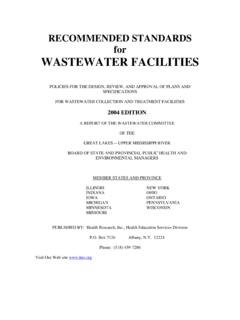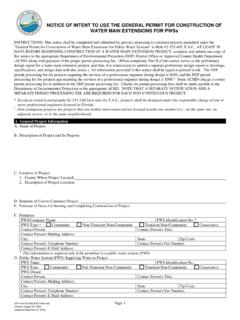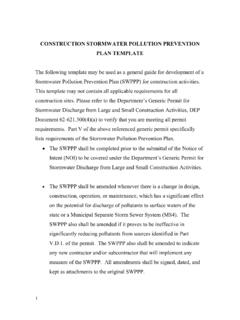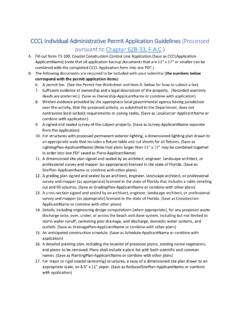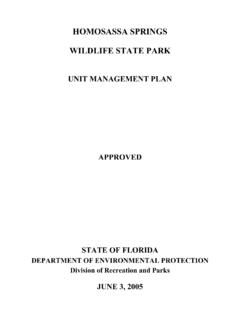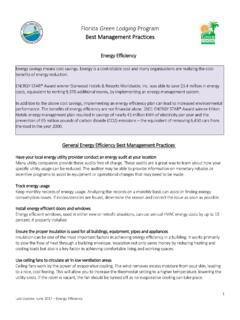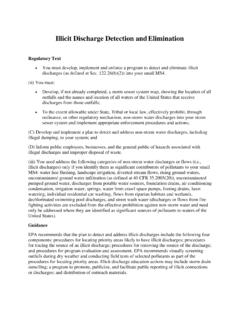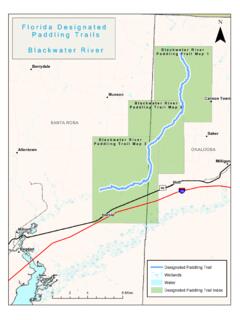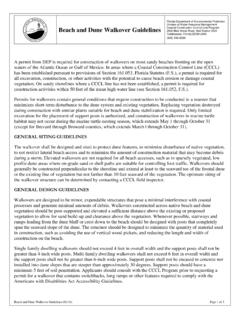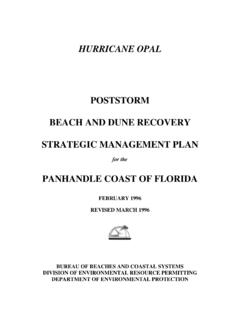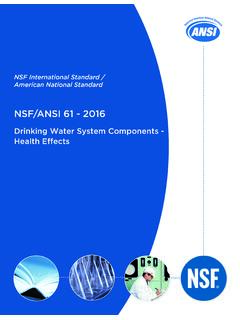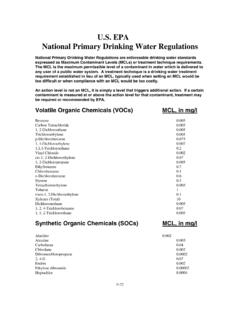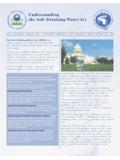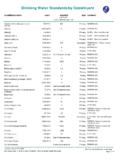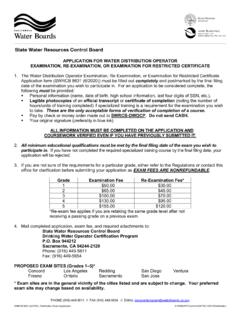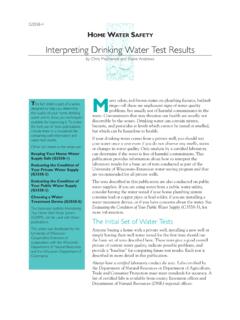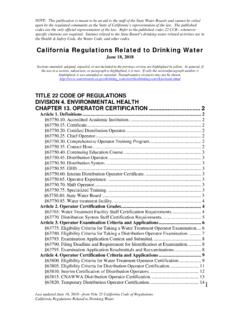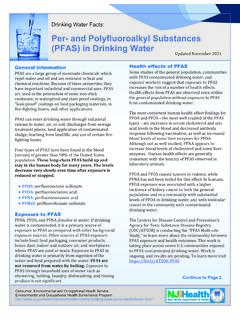Transcription of Requirements for Community Public Drinking Water Systems
1 Updated 10-20-15 FLORIDA DEPARTMENT OF ENVIRONMENTAL PROTECTION RICK SCOTT GOVERNOR CARLOS LOPEZ-CANTERA LT. GOVERNOR JONATHAN P. STEVERSON SECRETARY Requirements for Community Public Drinking Water Systems Contents 1) Introduction .. Page 1 2) Operators .. Page 2 3) Required levels of chlorine .. Page 2 4) Chemical and bacteriological monitoring schedules .. Page 2 5) Chemical and bacteriological monitoring sampling plans .. Page 2 6) Annual operating license fees .. Page 4 7) Monthly operation reports .. Page 5 8) Extension of the distribution system and plant modifications.
2 Page 6 9) Abnormal occurrences and emergencies .. Page 7 10) Public notification of planned maintenance or repair work .. Page 8 11) Boil Water notices .. Page 8 12) Operation and maintenance logs .. Page 8 13) Good operating condition .. Page 9 14) Record of inspections, flushing and valve exercising .. Page 10 15) Emergency preparedness/response plan .. Page 10 16) Audio-visual alarm system for standby power .. Page 11 17) Cross-connection control program .. Page 11 18) Consumer confidence reports .. Page 11 19) Well abandonment .. Page 11 20) Transfer of ownership .. Page 12 21) Map of the Water distribution system .
3 Page 12 22) Maximum residence time grab sample .. Page 12 1) Introduction You are now responsible for a state-approved Community Public Water system (CWS). This responsibility involves the following duties, as required by Florida Administrative Code ( ) Rules 62-699, 62-550, 62-555 and 62-560. This document summarizes those Requirements that apply to Community Water Systems , but it is not intended to substitute for Rules 62-550 and 62-555. Please note that other types of Public Drinking Water Systems have different Requirements . Any forms which are referenced below can be obtained from the Department of Environmental Protection Drinking Water Section, 3520, 2600 Blair Stone Road, Tallahassee, Florida 32399-2400, as well as from the following website: Requirements for Community Public Drinking Water Systems Page 2 Any rules which are referenced below can be obtained from the following website: The Florida Department of Environmental Protection website can be found at.
4 2) Operators A Community Public Water supply utility must employ an operator certified with an appropriate Water plant operator license and Water distribution system operator license for the plant(s) and distribution system to perform tests, maintain records and submit reports required by Florida Administrative Code Rule 62-550. 62-699 lists the number and length of site visits by the certified operator, as well as what level of certification is required based upon plant size and complexity. Suppliers of Water shall employ licensed operation personnel in accordance with Chapter 62-602, which contains all Requirements for certified operators.
5 [ Rule (8) and ] 3) Required levels of chlorine Suppliers of Water shall maintain a free chlorine residual between milligram per liter (mg/L) and mg/L, or a combined chlorine residual between mg/L and mg/L, or an equivalent chlorine dioxide residual, throughout their Drinking Water distribution system at all times. If at any time the residual disinfectant concentration in any portion of a distribution system falls below the required minimum level, the supplier of Water shall increase the disinfectant dose as necessary and flush said portion of the distribution system until the residual disinfectant concentration is restored to the required minimum level.
6 [ (6)] 4) Chemical and bacteriological monitoring schedules Florida Administrative Code Rule through 335 sets maximum contaminant levels for Water in Public Drinking Water Systems , and Rule requires monitoring of these potential contaminants on a routine basis. Monthly bacteriological sampling is required from the wells and a number of locations in the distribution system . For future chemical monitoring schedule, please refer to Chapter 62-550, Florida Administrative Code. Also, shortly after a new PWS is cleared for Public use by the Department, the Department will issue a monitoring schedule.
7 5) Chemical and bacteriological monitoring sampling plans Provide the following prior to conducting required sampling: A) Stage 2 Disinfectants/Disinfection Byproducts Rule Monitoring Plan. An example format is available at the website listed below. [40 CFR (a)(1)] B) Written sampling plan for total coliform. Public Water Systems shall collect total coliform samples at sites that are representative of Water throughout the distribution system and in accordance with a written sampling plan that addresses location, timing, Requirements for Community Public Drinking Water Systems Page 3 frequency, and rotation period.
8 Descriptions of sampling locations shall be specific, , numbered street addresses or lot numbers. Pressure tank or plant tap samples are not acceptable for determining compliance. [ (1)] The number of required bacteriological samples is based upon the population of the system , and is reprinted below. POPULATION SERVED MINIMUM NUMBER OF ROUTINE SAMPLES PER MONTH 25 to 2,500 2,501 to 3,300 3,301 to 4,100 4,101 to 4,900 4,901 to 5,800 5,801 to 6,700 6,701 to 7,600 7,601 to 8,500 8,501 to 12,900 12,901 to 17,200 17,201 to 21,500 21,501 to 25,000 25,001 to 33,000 33,001 to 41,000 41,001 to 50,000 50,001 to 59,000 59,001 to 70,000 70,001 to 83,000 83,001 to 96,000 96,001 to 130,000 130,001 to 220,000 220,001 to 320,000 320,001 to 450,000 450,001 to 600,000 600,001 to 780,000 780,001 to 970,000 970,001 to 1,230,00 1,230,001 to 1,520,000 1,520,001 to 1,850,000 1,850.
9 001 to 2,270,000 2,270,001 to 3,020,000 3,020,001 to 3,960,000 3,960,001 or more 2 3 4 5 6 7 8 9 10 15 20 25 30 40 50 60 70 80 90 100 120 150 180 210 240 270 300 330 360 390 420 450 480 C) Asbestos-Free Certification or Asbestos Sampling Plan, form (10). D) Reduced Monitoring Application Questionnaire for Synthetic Organic Contaminants (SOCs), form (2). (If applicable, and if you wish to apply for reduced monitoring of the four quarter SOC requirement.) Requirements for Community Public Drinking Water Systems Page 4 E) Submit a Sampling Plan for Lead and Copper Tap Samples and Water Quality Parameters, form (12).
10 You need to submit the completed form for the Department s approval or comments as soon as possible. The number of samples for lead, copper and Water quality parameters is based upon the population of the system , and are reprinted below from (c) and (a)(2). system size (number of people served) Number of lead and copper sites Number of sites for Water quality parameters >100,000 100 25 10,001 to 100,000 60 10 3,301 to 10,000 40 3 501 to 3,300 20 2 101 to 500 10 1 <= 100 5 1 Please note that these are the standard number of sample locations, and may be reduced based upon results submitted to the Department.
